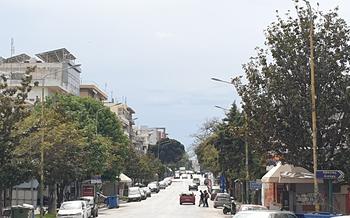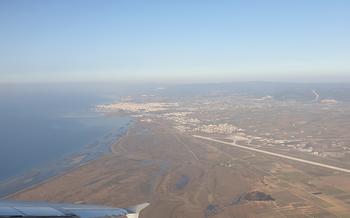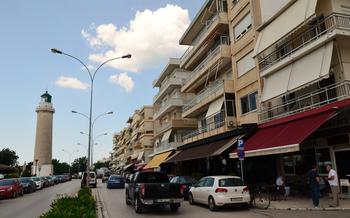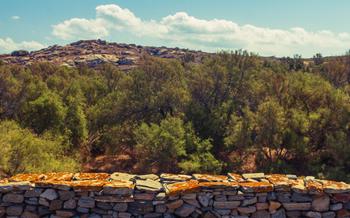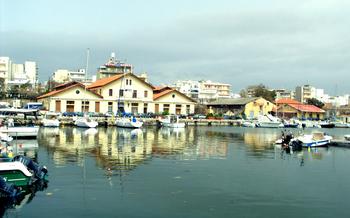
Sanctuary of the Great Gods, Samothraki
- Samothraki: The Sacred Island
- Exploring the Sanctuary
- The Mysteries of Samothraki
- Archaeological Discoveries
- The Sacred Way
- The Anaktoron
- The Museum of Samothraki: A Treasure Trove of Ancient History
- Visiting the Sanctuary Today: A Journey Through History and Spirituality
- Insider Tip: Unveiling the Hidden Treasures of Samothraki's Sanctuary
Samothraki: The Sacred Island
Samothraki, the fifth-largest island in the North Aegean Sea, holds a significant place in Greek mythology and history. Located off the coast of Thrace, Samothraki served as a sacred sanctuary during antiquity, attracting pilgrims and devotees from across the ancient world. Its strategic position in the northern Aegean made it a crossroads of cultures and religions, contributing to the island's unique spiritual heritage.
During the Archaic and Classical periods, Samothraki was renowned for its religious significance and was considered one of the most important sanctuaries in the Greek world. The island was believed to be the birthplace of the Cabeiri, mysterious deities associated with fertility, the underworld, and the sea. The Cabeiri were worshipped alongside other gods, including Zeus, Hermes, and Dionysus, making Samothraki a center of polytheistic worship and religious rituals.
Samothraki's sacred status was further enhanced by its diverse natural beauty. The island's mountainous terrain, lush forests, and stunning coastline created a landscape that was both awe-inspiring and conducive to spiritual contemplation. This combination of natural beauty and religious significance made Samothraki a place of pilgrimage and veneration for centuries.
Today, Samothraki remains a place of great historical and cultural importance. The island's rich heritage is reflected in its archaeological sites, museums, and traditional customs. Visitors to Samothraki can explore the ancient sanctuary, marvel at the island's natural beauty, and immerse themselves in the unique cultural traditions that have been passed down through generations.
Exploring the Sanctuary
The Sanctuary of the Great Gods on Samothraki is a sprawling complex that reveals the rich history and religious significance of the island. Its layout and architecture mirror the significance of the sanctuary and the rituals that took place within its sacred grounds.
The sanctuary's most striking feature is the Hieron, a sacred precinct containing the main temples dedicated to the Great Gods. Here, visitors can marvel at the remains of these ancient temples, including the Temple of the Great Gods, the Arsinoe Rotunda, and the Anaktoron.
Altars, where offerings were made to the deities, are scattered throughout the sanctuary, each serving a specific purpose in the rituals and ceremonies that took place here. Inscriptions and dedications found on these altars provide valuable insights into the names and attributes of the gods worshipped at Samothraki.
Among the most fascinating discoveries at the sanctuary are the mysteries, secret religious rituals reserved for the initiated. While the exact nature of these mysteries remains shrouded in secrecy, archaeological evidence suggests that they involved symbolic purification rites, processions, and initiations.
Exploring the Sanctuary of the Great Gods is a journey through time, allowing visitors to connect with the spiritual and religious practices of the ancient Greeks. Each structure, inscription, and artifact tells a story, piecing together the puzzle of this sacred site's significance in the ancient world.
The Mysteries of Samothraki
The Sanctuary of the Great Gods was not just a place of worship; it was also a center for the initiation into secret religious rituals known as the Mysteries of Samothraki. These mysteries were shrouded in secrecy, and their exact nature is still not fully understood. However, ancient sources suggest that they involved elaborate initiation rites and ceremonies, including symbolic purification, sacred vows, and the revelation of secret knowledge.
The initiates, or mystes, were required to undergo a period of purification and preparation before being admitted to the mysteries. They would bathe in the sacred waters of the island, offer sacrifices to the gods, and make vows of secrecy. The initiation ceremonies themselves were held in secret chambers within the sanctuary, and the details of what transpired remain a mystery.
The mysteries were believed to confer spiritual benefits on the initiates, including purification, protection, and enlightenment. They were also seen as a way to connect with the divine and to learn about the secrets of the universe. The Mysteries of Samothraki were highly respected and influential in the ancient world, and they attracted initiates from all over the Mediterranean region.
The symbolism of the sacred objects and symbols used in the mysteries was rich and complex. The most important symbol was the winged serpent, which represented the divine power of the Great Gods. Other symbols included the torch, the snake, and the egg, which were associated with fertility, rebirth, and immortality.
The Mysteries of Samothraki had a profound influence on other mystery cults in the ancient world, including the Eleusinian Mysteries in Greece and the Mithraic Mysteries in Rome. They also influenced early Christian thought and symbolism, and some scholars believe that the Christian sacrament of baptism may have originated from the purification rituals of the Samothracian mysteries.
Archaeological Discoveries
The Sanctuary of the Great Gods has yielded a treasure trove of archaeological discoveries, shedding light on the island's rich history and religious practices. Excavations conducted over the years have unearthed a wealth of artifacts, including exquisite sculptures, intricate inscriptions, and votive offerings. These discoveries have played a crucial role in enhancing our understanding of ancient Greek art and culture.
Among the most notable finds are the famous Winged Victory of Samothrace, a masterpiece of Hellenistic sculpture that once adorned the sanctuary. This awe-inspiring statue, now prominently displayed in the Louvre Museum in Paris, epitomizes the artistic prowess and technical virtuosity of the ancient Greeks.
In addition to the Winged Victory, archaeologists have unearthed numerous other significant artifacts, including marble and bronze statues, ceramic vessels, and jewelry. These objects provide valuable insights into the religious practices and rituals that took place at the sanctuary. For instance, the discovery of numerous votive offerings, such as terracotta figurines and bronze statuettes, attests to the widespread devotion to the Great Gods among the ancient Greeks.
Ongoing excavations and research projects continue to uncover new artifacts and information, further enriching our understanding of this sacred site. The ongoing exploration of the sanctuary promises to yield even more exciting discoveries in the years to come, providing valuable insights into the religious and cultural heritage of the ancient world.
The Sacred Way
The Sacred Way, a processional path paved with large stone slabs, extends from the port of Samothraki to the Sanctuary of the Great Gods. This sacred route holds immense ritualistic significance, as it was used by pilgrims and worshippers during religious festivals and processions. Along the way, they would stop at various sacred sites, each with its own significance and symbolism.
The Sacred Way serves as a symbolic journey, representing the spiritual transformation and purification that pilgrims underwent before entering the sanctuary. As they walked along this path, they would leave behind the mundane world and enter a realm of sacredness and devotion. The Sacred Way thus played a crucial role in creating a sense of anticipation and reverence among those who sought to experience the mysteries of Samothraki.
The Sacred Way connects several sacred sites on the island, including the Rotunda of Arsinoe, the Hieron, and the Anaktoron. Each of these sites served a specific purpose in the religious rituals and ceremonies of the sanctuary. By following the path, pilgrims could experience the sacred landscape of Samothraki and immerse themselves in the island's rich spiritual traditions.
The Anaktoron
The Anaktoron stands as a remarkable structure within the Sanctuary of the Great Gods, serving as a sacred edifice dedicated to the performance of specific rituals and ceremonies. Its unique architectural features set it apart from other buildings at the site. Constructed in the 4th century BCE, the Anaktoron boasts a rectangular layout with a distinctive double-gabled roof. Its interior is characterized by a spacious hall flanked by two rows of Doric columns, creating a solemn and awe-inspiring atmosphere.
The Anaktoron served as a pivotal location for the initiation rites associated with the mysteries of Samothraki. During these sacred ceremonies, neophytes underwent a profound transformation as they journeyed through various stages of initiation, seeking spiritual enlightenment and a deeper connection with the divine. Within the Anaktoron's sacred confines, they engaged in rituals, performed offerings, and received guidance from the priests and priestesses who presided over these enigmatic rites.
The symbolism embedded in the Anaktoron's architectural elements further enhances its significance. The double-gabled roof, for instance, represents the duality of the sacred and the profane, while the Doric columns symbolize strength and stability. Together, these elements create a sacred space that is both awe-inspiring and conducive to spiritual introspection.
The Anaktoron's enduring presence at the Sanctuary of the Great Gods serves as a testament to the profound spiritual significance it held for the ancient Greeks. Its unique architectural design and ritualistic purpose combine to create a truly exceptional monument, inviting visitors to delve into the mysteries and spirituality that permeated this sacred site.
The Museum of Samothraki: A Treasure Trove of Ancient History
Located in the picturesque town of Kamariotissa, the Museum of Samothraki is a must-visit for anyone interested in the island's rich history and cultural heritage. The museum houses an impressive collection of artifacts, sculptures, and inscriptions that provide a glimpse into the religious practices and daily life of the ancient Samothracians.
Among the highlights of the museum's collection is the famous Winged Victory of Samothrace, a stunning marble statue that once adorned the Sanctuary of the Great Gods. Other notable exhibits include intricate votive offerings, inscriptions, and sculptures that shed light on the mysteries and rituals performed at the sanctuary.
The Museum of Samothraki plays a crucial role in preserving and showcasing the island's unique heritage. Its collections offer a tangible connection to the past, allowing visitors to gain a deeper understanding of the ancient civilization that flourished on Samothraki.
Visiting the Sanctuary Today: A Journey Through History and Spirituality
Practical Information for a Meaningful Experience:
Planning a visit to the Sanctuary of the Great Gods in Samothraki is an enriching experience that allows you to connect with the island's rich history and spiritual heritage. Here are some practical tips to make the most of your visit:
-
Access and Transportation: The sanctuary is situated on the southwestern coast of Samothraki and can be reached by car or taxi from the main town of Kamariotissa. Public transportation is also available, with buses connecting the town to the sanctuary.
-
Guided Tours and Self-Exploration: Enhance your visit by joining a guided tour led by knowledgeable experts who can share insights into the sanctuary's history, mythology, and religious significance. Guided tours are offered in various languages, providing an in-depth understanding of the site. Alternatively, you can explore the sanctuary at your own pace, allowing you to soak in the atmosphere and marvel at the ancient ruins.
-
Plan Your Visit: Allocate enough time to fully explore the sanctuary and its surroundings. Set aside at least half a day to wander through the ruins, admire the artifacts in the museum, and soak in the breathtaking views of the Aegean Sea. Comfortable footwear and sun protection are recommended, as the site offers limited shade.
-
Capture the Essence: The sanctuary offers a photographer's paradise, with stunning views, ancient ruins, and natural beauty. Bring your camera to capture the essence of this sacred place, creating lasting memories of your journey to Samothraki.
Insider Tip: Unveiling the Hidden Treasures of Samothraki's Sanctuary
Beyond the well-trodden paths of the sanctuary, there lie hidden gems waiting to be discovered. For those willing to venture off the beaten track, the rewards are abundant.
Explore the lesser-known corners of the sanctuary, where ancient ruins and artifacts whisper untold stories. Discover the secluded nooks where nature and history intertwine, offering moments of tranquility and contemplation.
Attend one of the special events or festivals held throughout the year, when the sanctuary comes alive with music, dance, and traditional rituals. Immerse yourself in the vibrant culture of Samothraki and experience the island's rich heritage firsthand.
To fully appreciate the sanctuary's magic, plan your visit during the shoulder seasons (spring or autumn) when the crowds are smaller, and the weather is still pleasant. This allows you to savor the serenity of the site and connect with its spiritual essence more deeply.
Don't miss the unique experiences and activities that Samothraki offers. Embark on a guided hike through the island's lush forests, discovering hidden waterfalls and breathtaking views. Take a boat trip around the island's stunning coastline, marveling at the towering cliffs and secluded coves.
Samothraki's Sanctuary of the Great Gods is a treasure trove of ancient history, natural beauty, and spiritual significance. With a little exploration and an open heart, you can uncover its hidden wonders and create memories that will last a lifetime.

